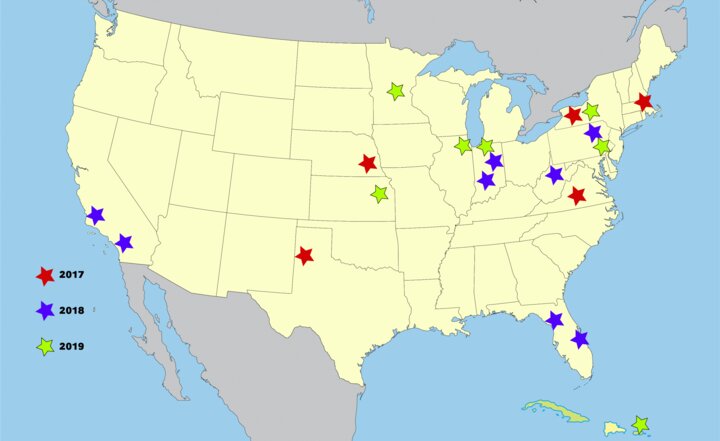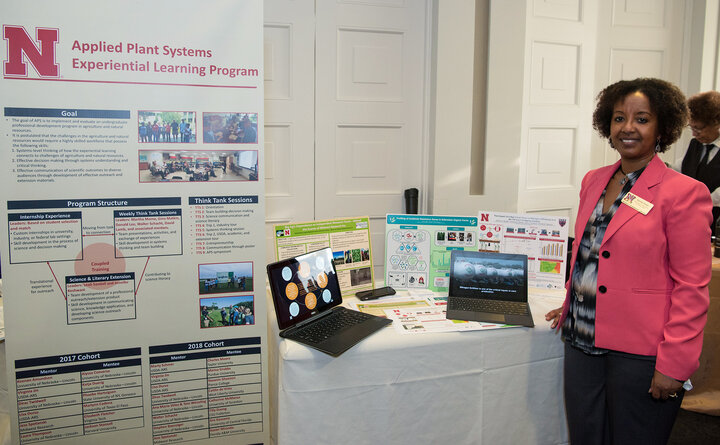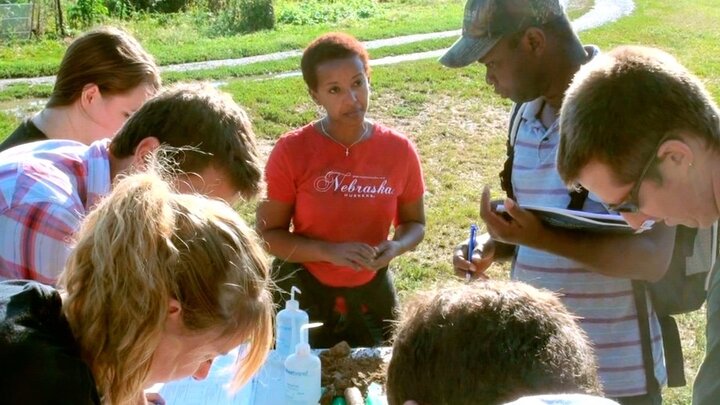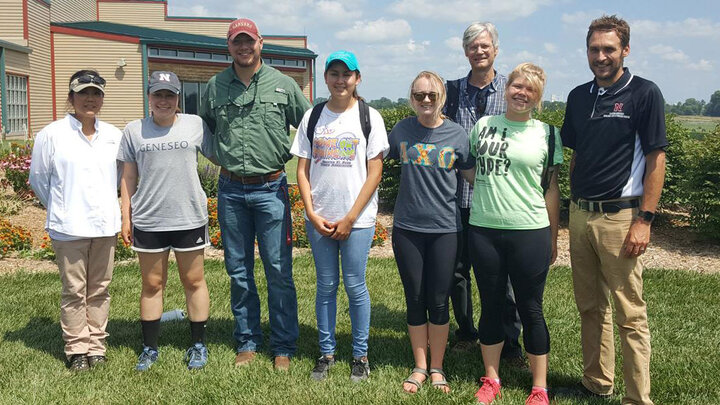Home Institutions of Participating Students
The Applied Plant Systems Internship program has brought students from all over the United States to work with University of Nebraska researchers for the past three years.
In 2019, students came from the University of Puerto-Rico, Houghton College, Villanova University, Wheaton College, Saint Mary’s College, College of Saint Benedict and Washburn University to work with University of Nebraska researchers.
In 2018, students came from Pierce College, Purdue University, Taylor University, University of Scranton, West Liberty University, University of Central Florida, Florida A&M University and California State University, Fullerton.
In 2017, students came from Virginia Tech, State University of New York Geneseo, Texas Tech, Harvard University and the University of Nebraska–Lincoln.

Mamo presents Applied Plant Systems Experiential Learning Program at Agricultural Research Congressional Exhibition
Martha Mamo, interim associate department head and Weaver Professor of Agronomy and Horticulture, participates in the Association of Public and Land-grant Universities Agricultural Research Congressional Exhibition & Reception in Washington, D.C. More information at https://bit.ly/2LjnFfx.

Martha Mamo, Weaver Professor of Agronomy and Horticulture, presents APS program in Washington, D.C.
Project aims to develop agriculture, natural resource professionals
A new project at the University of Nebraska-Lincoln aims to prepare students to address the challenges of food production and the environment through hands-on learning experience and peer interaction. Funded by a $281,475 grant from the U.S. Department of Agriculture's National Institute of Food and Agriculture, the project will bring 24 students from across the country to Nebraska to conduct summer experiential internships related to their career interests and goals. Full story at http://bit.ly/2BBaXR7

Martha Mamo, Weaver Professor of Agronomy and Horticulture, works with Nebraska students. Dave Fitzgibbon | University Communication
Pure Nebraska interviews students
A summer internship program at the University of Nebraska at Lincoln is bringing in students from around the country to examine the issues surrounding the future of food production. In a studio interview, we hear from two students about the program.

Video Presentations
Where Do Greenhouse Gases Come From? by Marisa Grubb
https://youtu.be/H2WcGQlD_4Y
An Introduction to Plant Breeding, Genetics and Bioinformatics
https://aps2018.weebly.com/
The Agricultural Blind Spot by Xavier Miranda
https://mediahub.unl.edu/media/11249
Virus and Bacteria by Nazanin Ghetmiri
https://mediahub.unl.edu/media/11250
Antibiotic Resistance by Marlynn Cadena
https://youtu.be/MVGWpv0GpCI
Poster and PowerPoint Presentations
Download PowerPoint Presentation PDF's
Juniper recovery following initial restoration with fire: Implications for managers by Caitlin de Vries, Christine Bielski, Dillon Fogarty and Dirac Twidwell
Milkweed – Insects Frequently Found on Milkweed by Catherine McManus
Juniper recovery following initial restoration with extreme fire by Caitlin de Vries, Dillon Fogarty, Christine Bielski and Dirac Twidwell
How Does Size of Roadside Wildflower Islands Affect Wildflower Establishment? by Tilly Duong, Walter Schacht, Judy Wu Smart, Jon Soper and Kayla Mollet
Impact of Manure & Nitrogen on the Amount of Antibiotic Resistance Genes in Soil by Nazanin Ghetmiri, Lisa M. Durso, Virginia L. Jin and Marty R. Schmer
Effects of Corn Residue and Cover Crops on Soil Greenhouse Gas Emissions by Marisa Grubb, Virginia Jin and Marty Schmer
A Genetic Conundrum: Evaluation of a Wheat Breeding Selection Program by Sire Kassama and P. Stephen Baenziger
Exploring Milkweed Health in Agricultural Landscapes by Catherine A. McManus, Matthew Greiner, Ana M. Vélez Arango, and Thomas J. Weissling
The Impact of Drone Crop Monitoring on the Efficiency of Research Farms by Xavier Miranda and Jess Spotanskir
Nitrogen Source and Rate Effects on Corn Yield and Economics in the Western Corn Belt by Charles Moore, Marty Schmer and Virginia Jin
Tetracycline and Sulfonamide Antibiotic Resistance Genes in Soils From Nebraska Organic Farming Operations by Marlynn Cadena (2017 co-hort), Lisa M. Durso (mentor), Daniel N. Miller, Heidi M. Waldrip, B. L. Castleberry, Rhae A. Drijber and Charles Wortmann
Front. Microbiol., 28 June 2018 | https://doi.org/10.3389/fmicb.2018.01283.
Expectations and Experience of Mentoring in an Undergraduate Summer Research Internship by Carol A. Speth, Martha Mamo, Donald J. Lee, Leah Sandall, & Salvador Ramirez II, Department of Agronomy & Horticulture, University of Nebraska - Lincoln, Lincoln, NE.
Big Ag’s Dependence on Independent Research Farms – Behind the Scenes of Midwest Research Inc. by Bodie Fletcher, Virginia Polytechnic Institute and State University; Mentor: Jess Spotanski, Midwest Research Inc.
The focus of this study was to gain an understanding of the role and importance of independent research farms, such as Midwest Research Inc., in the agricultural industry.
Profiling of Antibiotic Resistance Genes in Nebraskan Organic Farms by Marlynn Cadena – University of Texas at El Paso; Lisa Durso – USDA-ARS; Charles Wortmann – University of Nebraska–Lincoln
There are three different aspects when talking about antibiotic resistance and each brings their own research.
Prairie restoration using extreme fires & spatial regime monitoring in the Great Plains by Phoebe Hartvigsen, Christine Bielski and Dirac Twidwell
Eastern redcedar (Juniperus virginiana) is a native invasive species in the Great Plains where it has spread into grasslands, decreasing biodiversity, reducing valuable rangeland forage for livestock, and increasing wildfire risk. Studies focused mainly on burn sites, treating these areas as complex adaptive systems—systems with individual components that adapt based on their interactions.
What is plant breeding? by Alyssa Converse
Plant breeding has existed for thousands of years, since humans have been growing plants for food. Today, it can be done in a variety of ways and is utilized by gardeners, farmers, biotechnology companies and individuals alike.
The Impact of a Rye Cover Crop on Nitrogen Efficiency in a No-Till Corn Cropping System by Jackson S. Stansell, Leonardo M. Bastos, Laura J. Thompson and Richard B. Ferguson
The objective of this study was to determine to what extent a rye cover crop changes the nitrogen efficiency of a corn cropping system without statistical reduction in crop performance and to predict an optimal nitrogen rate for this system.
The Benefits of Bats by P. Hartvigsen
Infographic on the benefits of bats and how to help preserve them.
Ornamental Pearl Millet: An Introduction to Plant Breeding by Alyssa Converse
This PowerPoint show gives an introduction to breeding ornamental pearl millet.